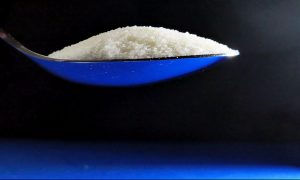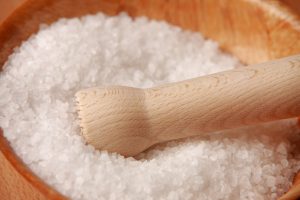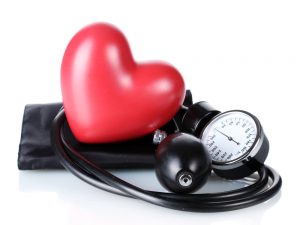Salt is the Leading Dietary Risk Factor in our Diet! How Much is Too Much?
Posted by Phil Heler, MD on May 18, 2019Salt intake has been identified as a key dietary risk in global diet by the Global Burden of Disease study.
Salt has been valued as a trading commodity throughout civilization for millennia. It has been used as a religious offering in ancient Egypt and as a valuable trade item between the Phoenicians and their Mediterranean empire. Its value is such that even word “salary” was derived from the word salt.
In ancient Rome the soldiers who worked for the Roman empire got a handful of salt in return as their payment each day. This is where the common saying of “being worth one’s salt” comes from.
Salt has also played a vital part in religious ritual in many cultures, symbolizing purity. There are more than 30 references to salt in the Bible, including the well-known expression “salt of the earth.”
On a personal note even my home town of Nantwich in Cheshire was so called because its connection with salt. The name “Nantwich” is derived from the Welsh name “Nant yr Heledd Wen” meaning the ‘stream of the white salt pit’. Salt is also a great flavour amplifier.
I remember, when I was at cookery school being offered two identical dishes, one of which was correctly seasoned. Salt is a universal flavour improver because at low concentrations it will reduce bitterness but at the same time increase sweetness, sourness and umami, which is desirable for sweet recipes. But at higher concentrations it suppresses sweetness and enhances umami, which is good for savoury things.
I was amazed how much better the correctly seasoned dish tasted…night and day compared to the other! I was also amazed just how much salt it took to achieve this.
A chef’s pinch turned out to be quite a lot! It is therefore no surprise that often more than 70% of the sodium (or salt) we consume potentially comes from packaged, prepared and restaurant foods. The rest of the sodium in the diet typically occurs naturally in food (about 15 percent) or is added when we’re cooking food or sitting down to eat (about 11 percent).
Salt is and Essential Part of Our Diet
The key point is that salt is an essential element in our diet, not only for us, but for all animals, and even for many plants.
So why do we need it? Salt plays a key role in conducting nervous impulses, contracting your muscles, keeping you hydrated and regulating your body’s pH levels and maintaining our acid-base balance. In warmer climates or with intense exercise our requirement increases.
An electrolyte (such as salt) is the umbrella term for particles that carry a positive or negative electric charge. In basic nutritional terms, an electrolyte refers to essential minerals found in your blood, sweat and urine. When these minerals dissolve in a fluid, they form electrolytes — positive or negative ions used in metabolic processes.
This includes sodium, potassium, chloride, calcium, magnesium, phosphate and bicarbonate. These electrolytes are present in the extracellular fluids that surround the cells in our bodies. This extracellular fluid needs to have a stable composition of electrolytes (and also pH). Our kidneys help maintain this balance.
This balance is maintained by a series of hormones acting on our two kidneys. These are renin, erythropoietin; the kidneys also have a role in making inert Vitamin D biologically useful, this is essential for calcium absorption. The kidneys recognise and act upon a series of messages (delivered by hormones) that vary according to how much fluid we drink.
If we do not drink enough, the blood and fluid volume become more concentrated and, as a result, the kidneys excrete a more concentrated urine. If an excess of fluid is drunk, the body fluids become more diluted, and the kidneys excrete a more dilute urine, getting rid of the excess that has been taken in.
These mechanisms are very efficient. If the body is in a satisfactory balance, approximately 80% of ingested fluid is excreted within an hour. The kidneys filter in total approximately 180 litres of fluid every day!
Your kidneys utilise the optimal balance of sodium and potassium to allow excess water to be collected from your bloodstream. This fluid passes through a membrane because of the osmotic pressure difference created by electrolyte balance.
Each of your kidneys is made up of about a million filtering units called nephrons. Each nephron includes a filter, called the glomerulus, and a tubule.
The nephrons work through a two-step process: the glomerulus filters your blood, and the tubule returns needed substances to your blood and removes wastes. As blood flows into each nephron, it enters a cluster of tiny blood vessels—the glomerulus. The thin walls of the glomerulus allow smaller molecules, wastes, and fluid—mostly water—to pass into the tubule.
Larger molecules, such as proteins and blood cells, stay in the blood vessel. A blood vessel runs alongside the tubule. As the filtered fluid moves along the tubule, the blood vessel reabsorbs almost all the water, along with minerals and nutrients your body needs. The tubule helps remove excess acid from the blood. The remaining fluid and wastes in the tubule become urine.
What Happens if we Consume too Much?
If there is excess sodium in your blood it disturbs electrolyte equilibrium. This decreases the ability to remove excess fluid and thus increases our blood volume.
The increase in blood volume in the body causes a local increase pressure in the immediate vascular system surrounding the kidneys, eventually causing damage. The same damage with also occur globally in the cardiovascular system.
In response to increased pressure the smooth muscle in arterial walls becomes stronger and thicker, causing a narrowing of the arteries, this reduces blood flow and in turn generates even more pressure.
This process ultimately delivers less blood to our hearts, causing a slow progression of chronic cardiac insufficiency, also forcing the heart to work harder and harder. This raises the risk of heart attacks and strokes.
The risk of high salt intake was very clearly highlighted in the ground breaking worldwide study I commented on in my last article called Global Burden of Disease.
This huge study identified excess salt intake as the key principle dietary risk factor in global diet. As I reported in my last piece, China especially consumes enormous amounts of salt with soy sauce and other salty sauces being a key part of the country’s cuisine.
The rising popularity of processed foods is introducing yet more salt to their diet. It has the highest death rate related to salt intake of any country. In China 80 per cent of communities had a sodium intake of more than five grams a day.
The high salt intake included in the Chinese national diet, according to some sources, also extends to Chinese Takeaways. ‘Action on Salt’ is run by a leading group of health experts in the UK.
They even suggest that some of the worst offending Chinese takeaway meals and ready meals should even carry compulsory health warning labels on menus and packaging to alert consumers to “astonishing and harmful” salt levels (perhaps this might be a bit extreme!) !
‘Action on Salt’ commissioned a study of 141 supermarket Chinese ready meals. Results demonstrated that nearly half (43%) were high in salt – containing more than 1.5g/100g, or 1.8g per portion – which they state should trigger a red “traffic light” label.
Dishes from six Chinese restaurants were also analysed, with 97% found to contain 2g of salt or more. More than half (58%) contained in excess of 3g of salt per dish – half an adult’s maximum recommended daily intake.
Recommended Intakes
In the other countries meanwhile, communities appear to have an average sodium consumption of 3 to 5 grams a day (equivalent to 1.5 to 2.5 teaspoons of salt).The NHS recommends that, as adults, we should not more than 6g of salt per day.
So, what is our actual average salt intake in the UK? Tom Sanders, Professor Emeritus of Nutrition and Dietetics at King’s College London comments: “Intakes of salt in the UK have fallen over the past 30 years from over 12g per day to 7 to 8g per day, and this has been accompanied by a fall in average blood pressure of the population.”
NHS recommendations are very different when compared with the World Health Organisation (WHO) who recommend only 2g of salt per day. The American Heart Association meanwhile recommends even less — 1.5 grams of sodium a day for individuals at risk of heart disease. So, who is right?
NHS recommendations were well supported last year by another comprehensive study published in The Lancet by scientists from the Population Health Research Institute (PHRI) of McMaster University and Hamilton Health Sciences in Canada along with other research colleagues from 21 countries.
This was a very interesting study and followed 94,000 people, aged 35 to 70, for an average of eight years in communities from 18 countries around the world. The study found there was a definite associated risk of cardiovascular disease and strokes only when the average intake of salt was greater than five grams of sodium a day. As it turns out fewer than five per cent of individuals in developed countries exceeded that level.
This huge international study also appeared to demonstrate (somewhat controversially!!) that even for those individuals who exceeded 5g of salt per day the health risk was almost virtually eliminated if those individuals improved their diet quality by adding fruits, vegetables, dairy foods, potatoes, and other potassium rich foods.
One of the lead researchers commented: “We found all major cardiovascular problems, including death, decreased in communities and countries where there is an increased consumption of potassium which is found in foods such as fruits, vegetables, dairy foods, potatoes and nuts and beans.”
But do not be fooled by this. Graham MacGregor, the chairman of Action on Salt and a Professor of Cardiovascular Medicine at Queen Mary University of London commented: “Salt is the forgotten killer as it puts up our blood pressure, leading to tens of thousands of unnecessary strokes, heart failure and heart attacks every year.” According to superstition throwing salt over the left shoulder may well blind the devil and thwart bad luck, but it will also help our health!



